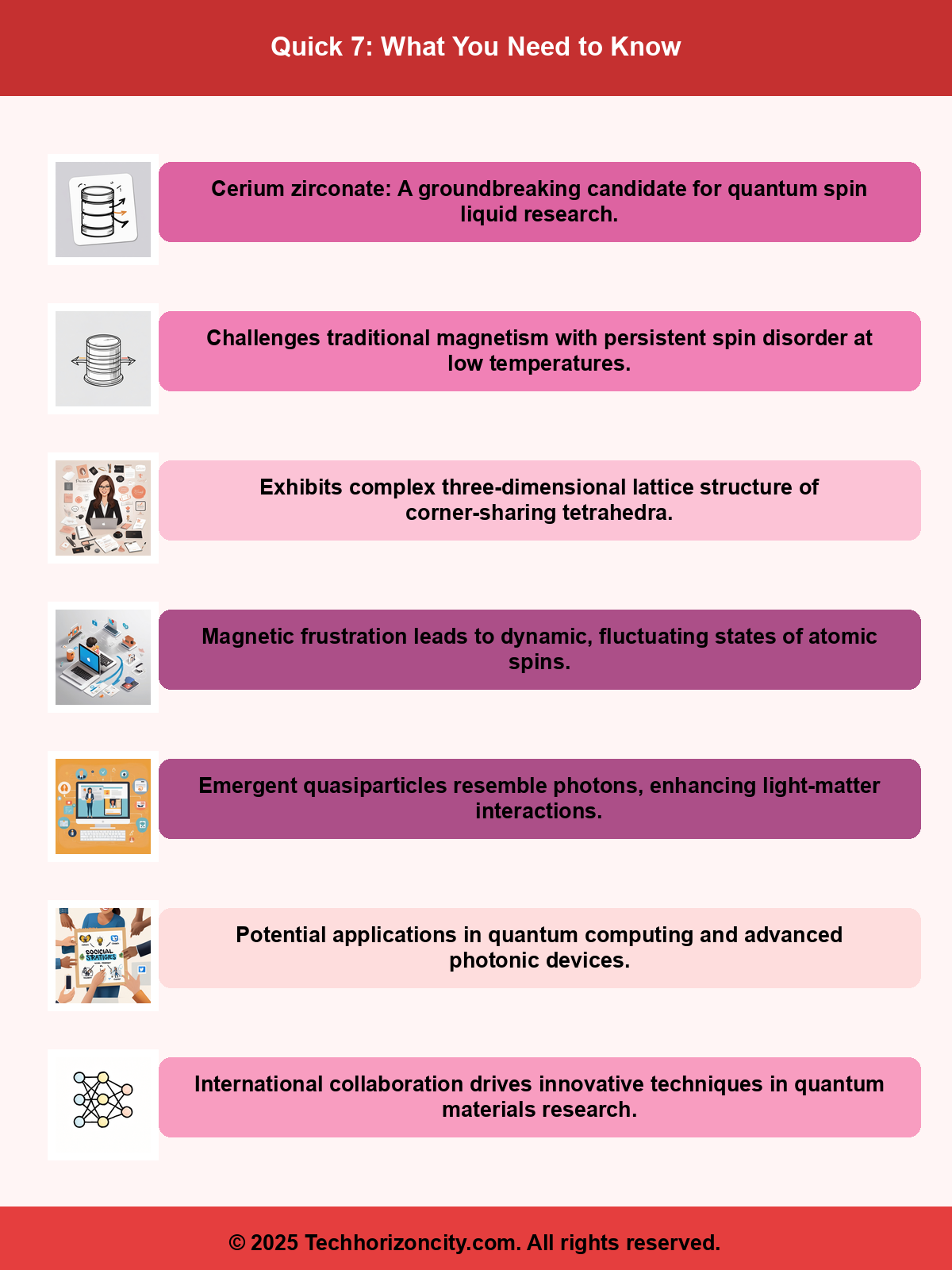Executive Summary
In the ever-evolving field of quantum materials, cerium zirconate (Ce₂Zr₂O₇) has emerged as a groundbreaking candidate, identified as a probable three-dimensional quantum spin liquid. This novel material not only challenges our comprehension of magnetism but also presents exciting possibilities for future technologies, such as quantum computing and superconductors. An international collaboration involving esteemed institutions like TU Wien, Rice University, the University of Toronto, and Rutgers University has utilized advanced techniques, including polarized neutron scattering and heat capacity measurements, to unveil the complex properties of cerium zirconate. As this research advances our understanding of emergent phenomena in quantum systems, it prompts a reevaluation of established paradigms in physics and materials science.

Background Context
The concept of quantum spin liquids has fascinated physicists for decades, representing a state of matter characterized by the persistent disorder of atomic spins, even at temperatures approaching absolute zero. Unlike conventional magnetic materials, where spins align in an ordered pattern, quantum spin liquids maintain a dynamic, fluctuating state that defies traditional magnetism. This unique behavior is largely attributed to the intricate lattice structures of these materials, which can facilitate what is known as “magnetic frustration,” a phenomenon where competing interactions prevent the system from reaching a stable, low-energy configuration.
For technical resources and innovative solutions, please visit EchoesOfCreationUS for specialized technical resources.
Cerium zirconate, with its complex three-dimensional lattice composed of corner-sharing tetrahedra, exemplifies this concept of frustration. The material’s structure allows for a rich tapestry of interactions that can lead to the emergence of novel quantum phenomena, including the formation of emergent quasiparticles that exhibit properties akin to photons. These emergent photons offer intriguing insights into the interplay between light and matter within the quantum realm, potentially paving the way for groundbreaking applications in quantum information technologies.
Analysis of Implications
The implications of cerium zirconate’s properties are profound, extending far beyond its immediate scientific intrigue. The discovery of emergent photons suggests a new avenue for manipulating light at the quantum level, which could have transformative effects on the development of photonic devices. These devices, which use light for information processing and transmission, are crucial for the future of telecommunications and computing systems.
Discover exclusive offers and premium content at Active Living Offers – your gateway to enhanced productivity and lifestyle solutions.
Moreover, the characteristics of quantum spin liquids, particularly in materials like cerium zirconate, may lead to advancements in quantum computing. The unpredictable nature of spin arrangements can be harnessed to create qubits that are more robust against decoherence, a significant obstacle in the development of practical quantum computers. This could accelerate progress in achieving quantum supremacy, where quantum computers outperform classical counterparts in solving complex problems.
Industry Impact Assessment
The findings surrounding cerium zirconate could catalyze a paradigm shift in materials science and engineering. As industries increasingly invest in quantum technologies, the ability to design and utilize materials with exotic magnetic properties will be pivotal. Companies focused on quantum computing, energy storage, and advanced materials will likely seek to collaborate with research institutions to explore the practical applications of quantum spin liquids.
Furthermore, the innovations stemming from this research could influence the development of superconductors. If materials like cerium zirconate can be engineered to exhibit superconductivity at higher temperatures, the potential for lossless energy transmission could revolutionize power grids and electronic devices, presenting a monumental step toward sustainable energy solutions.
Future Outlook
The trajectory of research into cerium zirconate and other quantum spin liquids appears promising. As experimental techniques continue to advance, including methods to observe and manipulate quantum phenomena at unprecedented resolutions, scientists will be better equipped to unlock the secrets of these materials. The ongoing collaborations among leading academic institutions and research organizations are likely to yield further insights, potentially leading to a new class of quantum materials with tailored properties for specific applications.
Additionally, the integration of machine learning and computational modeling in materials science may expedite the discovery of new quantum spin liquids with desirable characteristics. As more materials are identified and characterized, the potential for creating hybrid systems that leverage the strengths of both classical and quantum properties will expand, ultimately enhancing the functionality and efficiency of next-generation technologies.
Conclusion with Key Takeaways
The research surrounding cerium zirconate as a likely three-dimensional quantum spin liquid marks a significant milestone in quantum materials science. By challenging conventional notions of magnetism and unveiling the concept of emergent photons, this study opens avenues for groundbreaking technological advancements. The interplay of physics and materials science is set to reshape our understanding of energy, computation, and information transmission.
Key takeaways include:
- Cerium zirconate showcases the unique properties of quantum spin liquids, defying traditional magnetic behavior and demonstrating emergent phenomena.
- Implications for quantum computing and photonic technologies are profound, potentially leading to more efficient qubits and advanced information processing systems.
- The collaborative nature of this research highlights the importance of interdisciplinary approaches in unlocking the potential of new materials.
- Future research and development in this field could pave the way for revolutionary advancements in energy transmission and storage, greatly impacting industries worldwide.
As we continue to explore the fascinating world of quantum materials, cerium zirconate stands at the forefront, exemplifying the possibilities that emerge when we venture beyond the conventional boundaries of physics.
Disclaimer: This article was independently created based on publicly available information and industry analysis.
